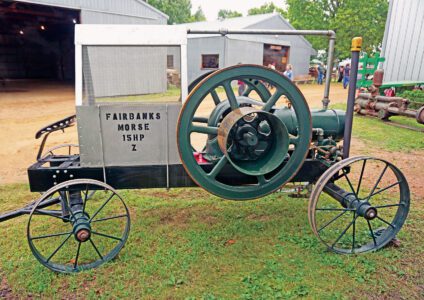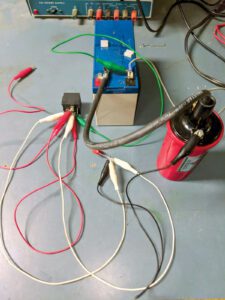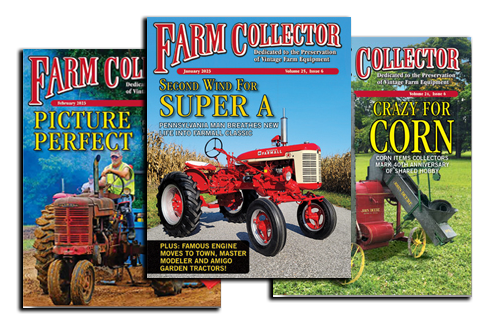1931 Fairbanks-Morse 15 hp Z
- Manufacturer: Fairbanks, Morse & Co., Beloit, Wis.
- Year: 1931
- Serial No.: 768581
- Horsepower: 15 hp @ 350rpm
- Bore & stroke: 8in x 10in
- Flywheel: 44in x 4in
- Ignition: Spark plug w/magneto
- Governing: Throttle
- Cooling: Water, screen-cooled
A few words from Dale Rieppel’s father, Erich, led Dale into a lifetime career working with big equipment. “Hey, you took it apart,” Dale’s father said to him once after Dale had disassembled a piece of equipment. “Now you can just put it all back together again.”
“That,” Dale says, “changed my life. I came to realize how difficult it can be to put things back together. I guess that’s what led me to a career in heavy construction equipment repair.” Before moving into heavy construction, Dale was a member of the Naval Construction Battalions, or Seabees.

Dale’s father provided a mentorship for Dale when he was a kid, helping him understand what made things tick by taking them apart and putting them back together, and that’s where it all started for Dale.
First engine
Dale got his first engine on the farm when he was 12. “My dad bought it for me to have an engine to play with, a 1930s Cushman Cub. I had to learn how to start it, and then make it run better. Mostly it was trial and error on my own part. But that wasn’t one I took apart – at least not until later,” he says with a laugh.
Dale says that his father – “A great man with only a third-grade education” – groomed Dale to be a mechanic and his brother to do the farming and look after livestock so they could keep the farm running. “I grew up as a farm tinkerer and have been repairing things since I was 5 or 6 years old,” Dale says.

Dale’s always been interested in engines – he still has that Cushman he learned to tinker on – but he didn’t get into collecting gas engines until he was facing retirement, the now 69-year-old says. “That’s when I started collecting a little bit. My collection is very small by many people’s standards, but everything I own runs, and I have them set up to do different things at shows.”
Dale says that people at shows are most appreciative when an engine is operating something. “I have one engine that crushes cans, while others shell and grind corn. People just like to see the engine doing something. Seeing an engine do something creates as much interest as anything, and is more educational for them than just seeing an engine run.” Dale likes to take six or seven engines to a show, usually in one load, “But if I take the big F-M, that’s one big load by itself, so that limits what I can take.”
1931 Fairbanks-Morse 15 hp Z
That “big F-M” is a 1931 Fairbanks-Morse 15 hp Model Z. “I always liked the sound of those big Fairbanks engines. I bought the 15 hp from the fellow who had found it.” He had mostly restored the engine, Dale says, but not everything. “It needed a fuel tank, and the factory cooling setup was a belt-driven water pump. When I bought the engine it had a 12-volt water pump on it, so I added a belt-driven water pump.”

The belt pulley also needed repair. “One of the mounting lugs was broken, and it was cracked. It”s not uncommon to see a little crack on the belt pulley.”
Dale says the engine is not entirely finished. “It’s missing the compensator on the carburetor, and I could use help finding parts for that,” Dale adds.
One interesting aspect about Dale’s engine is the truck beneath it. “It resembles what you might have bought when the engine originally came out, but these are made of steel instead of wood,” he notes. The truck is also equipped with a seat. “The seat was required because of the weight of these big engines. They were pulled around with a team of horses, and the driver needed a place to sit when they moved them out into the woods, for example, to hook them up to a buzz saw to cut wood, or to grind feed at the granary, or whatever the application was. Anytime you see a seat on one of these engines, it means it was horse-drawn.”

Another interesting feature on the 15 hp Z is its fuel pump. “The original factory fuel pump that you still see on some of them in operation today were apparently a little unreliable, so the company took it on themselves to replace them. Today, it’s not uncommon to have a car recalled because a part needs to be replaced. But this was built in 1931. As best I know, they offered the replacement fuel pump to people who had had trouble with it to install by themselves, but it’s possible they came out to repair the machine on the farm.” Dale’s engine has the updated fuel pump.
Running the Z
Starting the engine usually isn’t a problem, Dale says, “but,” he adds, laughing, “on any given day, these old engines can make you scratch your head. As simple as they are they still can cause you some grief!”
The major problem with Dale’s 15 hp Z is its size, he says. “Those engines are large, and it takes more than a little pickup truck to haul it to a show, so generally I trailer it. I winch it on and get it ready to go.”

From what Dale understands, engines of this 15 hp size and larger – the Z line was made up to a 20 hp size – were often used in grain elevators. “They ran a line shaft, which ran all their elevators and augers and grinding mills, and so forth. I was told the engine I have was found up in Canada where it pumped water for a town, but I wasn’t told what town it was.”
Dale says he doesn’t favor any engine line in particular, but although he only owns one, he does like upright engines. The first engine he bought when he stated to collect was a 1926 Sandwich upright. “It was originally designed as a milking machine engine, and since I grew up with cows to milk …”

What Dale enjoys most about old engines is seeing them repaired or restored and running. “I’m attracted to certain things, and when I hear the engine, the sound of it might be the difference, because they all have a unique sound. Then there’s the motion, the different mechanisms. Every one of them cycles a little differently,” he says.
So why does he collect? “Engines are in my blood,” he says, laughing, something that started when his father told him to put back together what he had taken apart. “I have always enjoyed learning how things are made and admiring the people who invented them. Being able to put them back together again and watching them work has always been very satisfying. It’s challenging and rewarding.”
Restoring A Vilter steam engine
More than 20 years ago, members of the Jordan, Minnesota, Scott-Carver Threshers’ Assoc. decided to restore a huge 150-ton, 1917 Vilter steam engine, one of three that had been used in the Armour & Co. meatpacking plant in St. Paul, Minnesota, the largest of the company’s 33 plants in the U.S. The 40-foot-long engine has an 18-foot flywheel, which together with the crankshaft weighs 35 tons.
As years went by, however, the project fell by the wayside. Some of the club’s members could no longer physically work on the project, some had passed away, and the project was basically abandoned. Until Dale Rieppel stepped into the picture in 2013.

“I put up a request to find people who would help restore it and get it finished, and got a list of volunteers and we went to work. I led a group of six of us who worked on it for four and a half years. The first part was finding the parts that had been scattered through the property after the engine had been taken apart 20 years ago,” he says.
Dale says they were fortunate to have a lot of pictures showing how it was originally assembled. When the club got the engine in 1989, club member Dennis Krill numbered all the parts and hired a photographer to document them. “Those pictures were real lifesavers,” Dale says. “There are probably 1,000 pieces of small pipe there, and when they were dismantled they were bundled and numbered, and the only thing that saved us was the pictures. They allowed us to identify all the parts, and when we got them all together and matched up we knew we had enough to put it together. We even found some extras.”

Then they began the long process of cleaning and preparing to assemble it, mostly on weekends. They finished the engine in time for the 2017 show, running it for the first time that August. “It was fun because everyone that volunteered came from a different walk of life; some mechanics, some engineers, some farm kids. It was just a fun time.” The Scott-Carver Threshers’ Assoc.’s annual Old-Time Harvest Steam & Gas Engine Festival is always the first weekend of August. The 2019 event will be the 56th annual show.
Contact Bill Vossler at Box 372, 400 Caroline Ln., Rockville, MN 56369; bvossler@juno.com






